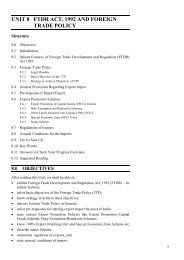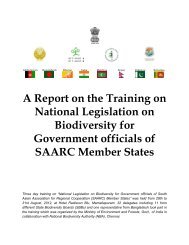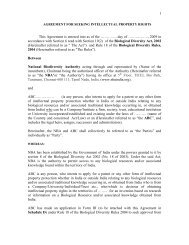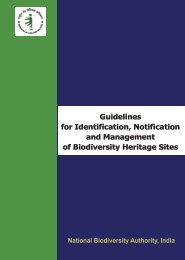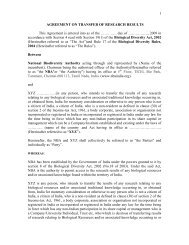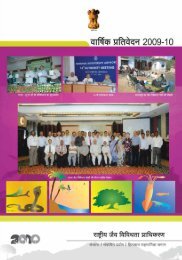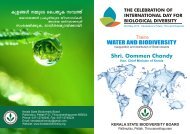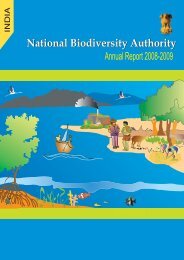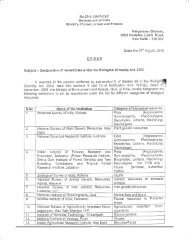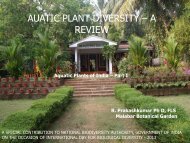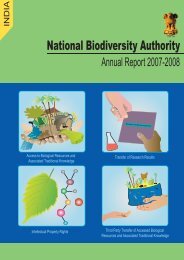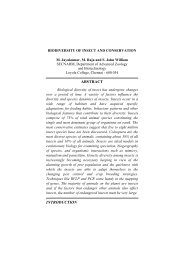PDF Format - National Biodiversity Authority
PDF Format - National Biodiversity Authority
PDF Format - National Biodiversity Authority
You also want an ePaper? Increase the reach of your titles
YUMPU automatically turns print PDFs into web optimized ePapers that Google loves.
BIODIVERSITY AND CONSERVATION OFMEDICINAL PLANTSJ. Suresh, P. Hemalatha and R. SelviHorticultural College & Research Institute, TNAUPeriyakulam East – 625 604ABSTRACTIndia is a vast repository of medicinal plants, accounting for more than 8,000species in its natural habitat. Indian system of medicines (ISM) such as Siddha,Ayurveda, Unani and the Homeopathy use around 2,000 species of herbal plants for theirtherapeutic uses. There are around 50 species, widely used under cultivation. About 90% demand of the herbal industry is met from the destructive forest collection. ThoughIndia has a rich biodiversity, the growing demand is putting a heavy strain on theexisting resources. While the demand for medicinal plants is growing, some of them areincreasingly being threatened in their natural habitat. This situation warrants for shortlisting conservation of these valuable resources for our own needs and for posterity.INTRODUCTIONIndia, with its diverse agro-climatic conditions and regional topography, has beenconsidered as the treasure house or botanical garden of plant genetic resources. Hence,India is recognized as one of the world’s top 12 mega diversity nations. Our herbalwealth constitutes more than 8,000 species and accounts for around 50 % of all higherflowering plant species of India; around 70 % of the medicinal plants in the country arespread across the tropical forests of Western Ghats. However, available informationshows that 1,800 species are used in Classical Indian systems of medicines. Ayurvedauses 1,200, Siddha – 900, Unani – 700, Amchi – 600, Tibetan – 450.The emerging field of herbal products industry holds a great potential to theeconomic development of the Indian region. Usage of herbs as a source of food,medicine, fragrance, flavour, dyes and other items in Indian systems of medicine is inincreasing trend. It is estimated that, 95 % of the medicinal plants used in Indian herbalindustry today are collected from wild. About half a million tonnes of dry material iscollected through destructive means indiscriminately and 1.65 lakh ha. of forest iscleaned and felled each year.With the increase in population, rapid expansion of area under food andcommercial crops, deforestation, extension of urban area, establishment of industries inrural areas, etc., there is considerable depletion of plant genetic resources wealth, manyof them being in the process of extinction day by day. (Vijayalatha, 2004 and Singh,2005).
In the present context of ‘back to nature’ in health care, it is very relevant that thevaluable plant species are not only preserved but also their cultivation developed in orderto meet the entire demand of the industries and export.Unless steps are being taken to conserve and increase the cultivation of importantplants, many of our native plant species will become extinct and endangered.
BIODIVERSITY – OVERVIEWAlthough there are around 8,000 medicinal plant species used by differentcommunities in India across different ecosystems, only around 10% of them (880species) are in active trade. Among these, around 48 species are exported in the form ofraw drugs and extracts, while around 42 species are imported. The wild populations ofabout 100 of the traded species are known to have declined, thereby making them to beconsidered threatened. This is the situation of raw drug trade in India that unfolds. Beforeascertaining the reasons for this, let us try to understand the “what”, “where” and “howmuch” of these raw drugs.HOW MANY HERBS?Habit wise analysis of these 880 medicinal plants, indicates that these are welldistributed across different life forms with the majority belonging to the herbaceouscategory. The highest proportion of herbs (41%), including grasses, is followed by trees(26%), shrubs (17%) and climbers (16%) (Fig. 1).Fig. 1. Proportion of different life forms of medicinal plant species in tradeHerbs41%Climbers16%Shrubs17%Trees26%BOTANICAL BASEIt is interesting to note that these 880 traded plants are distributed across 151families. Of these 79% belong to the Dicots while the Monocots constitutes 11%followed by Pteridophytes 5% and Gymnosperms 3% and one percent each from Fungiand Lichens. This indicates that a very small proportion of raw drugs belong to thecategory of lower classes in the plant kingdom (Table 2).
Table 2 : Classwise representation of traded medicinal plantsClassNo. of FamiliesDicots 119Monocots 17Pteridophytes 8Gymnosperms 5Fungi 1Lichens 1Familywise representation of these species is also quite interesting to note. Themajor share is from 10 families, viz., Bean family (Fabaceae), Aster family (Asteraceae),Castor family (Euphorbiaceae), Tamarind family (Caesalpiniaceae), Coriander family(Apiaceae), Basil family (Lamiaceae), Tomato family (Solanaceae), Cucumber family(Cucurbitaceae), Coffee family (Rubiaceae) and Hibiscus family (Malvaceae) (Table 3).Table 3 : Familywise representation of Traded Medicinal plantsFamilySpeciesFabaceae 67Asteraceae 54Euphorbiaceae 48Caesalpiniaceae 41Apiaceae 37Lamiaceae 37Solanaceae 35Cucurbitaceae 32Rubiaceae 29Malvaceae 28PART USED
These 880 plants yield a wide range of produce / parts that go as raw drugs. Theseinclude Roots (including tubers and rhizomes), Whole plants, barks, Stem (includingwood), Fruits, Seeds, Flowers, Leaves, Gum (including resin) and others. There are12,000 such botanical items (plant parts and products), which are obtained from these880 species(Table 4).
Table 4 : Partwise representation of traded medicinal plantsPartsNo. of EntitiesRoot 326Whole plant 167Fruit 161Seeds 141Leaves 122Bark 100Flower 72Stem 59Gum 30Others 22As most of these raw drugs are obtained from wild collections, this table alsogives you an idea of the extent of “destructive” collection inherent in medicinal plantstrade. About 66% of these plant entities are harvested for their roots, bark, wood, stemand the whole plant.REPRESENTATION OF TRADED MEDICINAL PLANTS ACROSS MEDICALSYSTEMSThe Medical system wise representation of these 880 medicinal plants is anotherinteresting point to note. It is found that the species are used widely across differentmedical systems. Ayurveda, Siddha, Unani, Tibetan, Folk, Homeopathy and Modern.Majority of these plants (82%) are used in Ayurveda system of medicine while the lowestshare (7%) is by Modern system. Similarly, Siddha accounts for 58%, Unani for 53%,Homeopathy for 16% and Tibetan for 25 % (Table 5).Table 5: Representation of traded medicinal plants across different Medical SystemsAyurvedaFolkHomeoModernSiddhaTibetanUnaniMedicalsystemwiseProportion(%) ofTradedSpeciesAyurveda 719 462 126 49 475 215 449 82Folk 462 607 99 44 408 178 343 69
Homeo 126 99 140 40 105 63 115 16Modern 49 44 40 65 40 20 45 7Siddha 475 408 105 40 508 193 366 58Tibetan 215 178 63 20 193 218 190 25Unani 449 343 115 45 366 190 469 53GEOGRAPHIC DISTRIBUTIONThe natural occurrence of traded species is another element of interest here. It isfound that these species are distributed across different bio-geographic zones, diversehabitats and landscape elements. About 18% of these species are confined to Himalayanand Trans Himalayan zone including North East India while around 4% is restricted toWestern Ghats and 0.5% is found only in the Desert zone. The rest of the species (around77%) have a wide range of distribution across the other bio-geographic zones of thecountry (Table 6).Table 6 : Examples of Traded species that occur in different Bio-geographic zonesS.No.Biogeographic zones (Bioticprovinces)Examples of the species1. Trans – Himalayan – 1(Tibetan – 1A)2. Himalayan – 2(North West Himalaya – 2Aand West Himalaya – 2B)3. Himalayan – 2(Central Himalaya – 2C andEast Himalaya – 2D)4. Desert – 3(Kutch – 3A, Thar – 3B)5. Semi – Arid – 4(Punjab – 4A, Gujarat – Rajwar– 4B)6. Western Ghats – 5(Malabar coast – 5A;Western Ghats mountains –Ephedra gerardiana, Hippophaerhamnoides, Physochlania praalta,Arnebia euchroma, FerulajaeschkeanaAconitum heterophyllum, Arnebiabenthamii, Dactylorhiza hatagirea,Podophyllum hexandrum, Picrohizakurroa, Pistacia chinensis.Nardostachys grandiflora, Rubiasikkimensis, Coptis teeta,Polygonatum cirrhifolium, Swertiachirayata, Valeriana jatamansi,Rhododendron anthopogon, Taxuswallichiana.Tecomella undulata, Tribulusrajasthanensis, Citrullus colocynthis,Commiphora wightii, Acacia niloticaBalanites aegyptiaca, Withaniacoagulens, Tribulus alatus,Commiphora wightii, Boswelliaserrata, Canscora, Acacia nilotica.Myristica malabarcia, Garciniaindica, Coscinium fenestratum,Hydnocarpus pentatandra, Garciniagummigutta, Vateria indica,
5B) Nilgirianthus ciliatus.7. North East India – 8(Brahmaputra valley – 8A andAssam hills – 8B)8. Deccan peninsula – 6(6A to 6E)Aquilaria malacensis, Smilax glabra,Ambroma augusta, Hydnocarpuskurzii, Vetivaria zizaniodes.Embelia tsjeriam-cottam,Caesalpinia digyna, Screberasweitenoides, Decalepis hamiltonii,Pterocarpus santalinus.ORIGIN AND SOURCEOf these 880 species, nearly 538 (61%) species occur only in the wild (with noknown cultivation), while 88 (10%) are recorded only under cultivation in India.However, 212 species (25%) are recorded both in wild and under cultivation. Theremaining 42 (4%) are not recorded in the wild or under cultivation in India and,therefore, inferred to be originated in other countries (Fig. 5).Fig. 5. Source of medicinal plants traded in India.Wild/Cultivated25%Cultivated10%Exotic4%Wild61%STATUS OF THESE TRADED PLANTSThe status of the natural populations of these plants is, however, not thatencouraging. A Rapid Assessment of selected Medicinal plants of Peninsular India andNorth India for their threat status as per IUCN guidelines has revealed that the wildpopulations of 100 species are facing different degrees of threat.Of these, 14 are threatened globally as these are endemic to India and deserveimmediate conservation attention (Table 7).Table 7: Endemic medicinal plants in trade
S.No.Botanical NameRed list statusGlobal1) Adhatoda beddomei CR2) Butea monosperma var. lutea EN3) Chlorophytum borivilanum VU4) Cinnamomum macrocarpum VU5) Decalepis hamiltonii EN6) Garcinia indica VU7) Gardenia gummifera VU8) Heracleum candolleanum VU9) Hydnocarpus pentandra VU10) Myristica malabarica VU11) Nilgirianthus ciliatus EN12) Pterocarpus santalinus EN13)Trichopus zeylanicusSubsp. travancorisEN14) Vateria indica VUIUCN RED LIST STATUS: CR- Critically Endangered, EN-Endangered, VU-VulnerableThe alarming situation of the involvement of “threatened” species, in trade, is notpeculiar to India alone. The Chinese Red Data Book lists 388 plant species, of which 69are found to be in trade.
MEDICINAL PLANTS IMPORTED INTO INDIAOf the 880 species about 42 species are imported. These include species likeGlycirrhiza glabra (Jeshtimadhu), Panax pseudoginseng (Ginseng), Commiphora myrrha(Hirabol), Boswellia frereana (African elemi), Uncaria gambier (Kath), and Salviahaematodes (Behman) amounting to 4.7% of the total traded species. Some of theseimported species are semi processed in India and are further exported as extracts. Theimported species are sourced from countries like Afghanistan, Bangladesh, Bhutan,Cameroon, China, Ghana, Indonesia, Iran, Morocco, Nepal, Pakistan, Singapore and SriLanka. It may be noted that the majority (16) of the imported drugs are from tree species.Fourteen drugs are from herbs while 9 are from shrubs and 3 from climbers. (NoorunnisaBegam and Ved, 2003).CONSERVATION AND DEVELOPMENTAL STRATEGIES FOR MEDICINALPLANTSSeveral national and international agencies have formulated appropriate policies andstrategies for the conservation of medicinal Plants. The world conservation strategy(IUCN, UNEP & WWF, 1980) defines conservation as “the management of human useof the biodiversity so that it may yield the greatest sustainable benefit to presentgeneration”. The primary goals of biodiversity conservation as envisaged in the worldconservation strategy are: Maintenance of essential ecological processes and life support systems on whichhuman survival and economic activities depend, Preservation of species and genetic diversity and Sustainable use of species and ecosystems, which support millions of ruralcommunities as well as major industries.NEED FOR BIODIVERSITY OF MEDICINAL PLANTSMedicinal plants are found in forest areas from the planes to the high Himalayaswith the greatest concentration in the tropical and subtropical belts and arid region of thedesert. Some of these, found at high altitudes in particularly stressful environments, growvery slowly and cannot live elsewhere. Others withstand more easily different ecologicalconditions.During the past decade, a dramatic increase in exports of medicinal plants atteststo worldwide interest in these products as well as in traditional health systems. In the last10 years, for example, India’s exports of medicinal plants have trebled. But with most ofthese plants being taken from the wild, hundreds of species are now threatened withextinction because of overharvesting, destructive collection techniques, and conversion ofhabitats to crop-based agriculture. For instance, the small coniferous Himalayan yew
(Taxus baccata) has recently become a heavily traded species. Similarly, senna is beinggrown extensively in arid regions of India.LOSS OF BIODIVERSITY OF MEDICINAL PLANTSThe medicinal plant wealth of India is declining constantly over the years.CAUSAL FACTORSMany factors both natural and manmade, have been responsible for limiting thedistribution of medicinal plants species and are causing them to become rare or evenextinct.1. Environmental factorsa) Rainfall: For the past few years the annual rainfall has decreased resulting in thehealth of many herbaceous species during summer months.b) Deforestations: Deforestations have been reported over the last two decades. Thespread of agriculture, logging, fire wood collection, heavy wood collection, heavygrazing, etc., are the main reasons for reduction in area under valuable forests. Manyvaluable wild medicinal plant species are eradicated or minimized every year due tothe deforestation activities.c) Siltation of water bodies: Siltation of water bodies in the forests has resulted in thereduction of water holding capacity heading to depletion of underground water.d) Lack of pollinators: Honey bee colonies have declined in numbers to the extent of 50-60%, in forests and other areas. Loss of pollinators has resulted in reduced seed setand dispersal of seeds.2. Developmental influencesa) Submersion: Loss of many species of medicinal plants has been noticed in forests dueto submersion, eg., the Maradavally forest is the catchments of Linganamakki Dam,the main reservoir of Karnataka for irrigation and power generation. Submersion ofnearly 10 sq. km of forest area during monsoons has resulted in loss of valuablemedicinal plant species.b) Infrastructure: Expansion of roads, installation of power lines and construction ofbuildings has caused extensive damage to forests and medicinal plants, eg.,Devanarayandurga forest in Karnataka.
3. Agriculture and forestry methodsc) Monoculture: There has been a progressive increase in monoculture plantations ofeconomically important indigenous as well as exotic species in forest. Monocultureplantation totally affects the organic productivity and reduces the natural stability andcomplexity resulting in loss of medicinal plants. eg., Eucalyptus and Acacia speciesin many forests.d) Encroachments: Encroachments over forestlands have assumed alarming levels.Apart from felling of trees and clearing vegetation, the cultivation practices followedon high sloppy lands has caused soil erosion, and decline of medicinal plant wealth.e) Overexploitation: Gathering of medicinal plants from the forests are rampant. Thecollection was by unorganized forest collectors, who, in turn sold the product to acontractor at the price fixed by the latter. But now, due to the awareness created bythe members of the ‘Local Traditional Medicinal Practitioners Association’, illegalgathering has been controlled to a certain extent.CONSERVATION OF BIOLOGICAL / GENETIC DIVERSITYConservation has been defined as the management of resources of the biospherefor the benefit of all life including human, so that sustainable benefit may be derived bythe present with potentials to meet the needs and aspirations of the future generations.Biological diversity refers to the richness of species, i.e., number of species in acommunity of living systems, while genetic diversity is a heritable diversity within andbetween the species of a genus. Basic rationale behind the conservation of biologicaldiversity is to ensure sustainability in the utilization of species and ecosystems bymarinating essential ecological processes in the life-support systems. Indian region is thecenter of diversity of 152 economic species.The concept of biosphere reserve is a method wherein specific ecosystems areconserved and managed for posterity. The germplasm collection in the herbalgardens/drug farms of valuable medicinal species can be a major tool in conservinggenetic/biological diversity. It will provide the basic material for future cultivation ofdesired plants (Sharma, 2004).IN SITU CONSERVATIONIn has been established that the best and cost effective way of protecting theexisting biological and genetic diversity is the ‘in situ’ or on the site conservationwherein a wild species or stock of a biological community is protected and preserved inits natural habitat. The prospect of such an ‘ecocentric’ rather than a species centered
approach is that it should prevent species from becoming endangered by human activitiesand reduce the need for human intervening to prevent premature extinctions. To achievethis in situ conservation the central government has initiated several measures recently bythe involvement of appropriate NGOs.MEDICINAL PLANTS CONSERVATION AREAS (MPCAs)Between 1993 and 1997 FRLHT (Foundation for Revitalization of Local HealthTraditions) Bangalore (Karnataka), in collaboration with State Forest departments hasestablished a coordinated network of 30 in situ medicinal plants conservation areaslocated with in the protected areas of Kerala, Tamil Nadu and Karnataka withinvolvement of local communities on conservation, inventorization, threat assessmentand Nursery Raising programme.The concept has received further boost through “Task force on Conservation andsustainable use of Medicinal plants” set up by GOI (1999) in the Planning Commissionwhich has recommended the establishment of 200 MPCAs, each of about 500 ha inmedicinal plants rich Protected Areas (Pas) of the country to cover different forest types.The key activities of the MPCAs include:‣ Systematic survey and documentation of intra-specific variation; generation ofdata on distribution pattern, macro- and micro-habitats, association and culturalinputs of each species.‣ Development of suitable species recovery programme of endangered andenrichment planting programme for economically valuable species.‣ Building up and strengthening community institution for long term managementof the sites.‣ Training of wildlife staff and others of in situ conservation of medicinal plants.The involvement of Botanical Survey of India (BSI), Department of Botany alongwith NGOs would ensure success of such initiatives.EX SITU CONSERVATIONConservation of medicinal plants can be accomplished by the ex situ, i.e., outsidenatural habitat by cultivating and maintaining plants in biotic gardens, parks and othersuitable sites, and through long term preservation of plant propagules in gene banks (seedbank, pollen bank, DNA libraries, etc.) and in plant tissue culture repositories and bycryo-preservation.
ETHNO-MEDICINAL PLANT GARDENSA valuable ex situ conservation measure would be the creating of a network orregional and sub-regional ethno-medicinal plant gardens, which should containaccessions of all the medicinal plants known to the various ethnic communities indifferent regions of India. The chain of gardens will act as regional repositories of ourcultural and ethno medicinal history and embody living traditions of our society’sknowledge of medicinal plants.GENE BANKSWhile it is known that the largest proportion of local biodiversity in all our ecosystemis used for medicinal purposes, very little is known about their conservation statusin the wild. What is likely is that a large number of medicinal plant species are undervarious degrees of threat. The ‘precautionary principle’ would suggest that an immediateand countrywide exercise be taken up to deposit seeds of endemic species. Asimultaneous effort should also be launched to evaluate the genetic variation of economicplants with a view to promoting their domestication and breeding.NURSERY OR DEMONSTRATION PLOTSThe most urgent task in order to ensure immediate availability of plants andplanting materials to various user groups like farmers, the professional Indian System ofMedicines (SM) community, plant breeders, industry and conservation organizations, isto promote nation-wide network of medicinal plant nurseries which will multiply all theregional-specific plants that are used in the current practice of traditional medicine. Thesenurseries should become the primary sources of supply of plants and seed material thatcan be subsequently multiplied by various users. The forest departments, agriculturalextension agencies, village panchayats, Non-governmental Organizations (NGOs) and privateenterprises should be encouraged to establish these nurseries or grow medicinal plants inexisting ones. In the initial years, interestfree short-term loans or loans at different ratesof interest can be offered by banking institutions to this nursery network.In view of its importance and urgency, Government can promote national coordinationof this program through a national nodal institution, which may be calledNATIONAL MEDICINAL PLANTS DEVELOPMENT BOARD.
CULTIVATION OR DOMESTICATIONThe medicinal plants should be domesticated and brought under cultivation tomaintain constant supply of quality materials and thus reduce the pressure on the wildpopulations. The process of domestication of a species involves characterization of itsreproductive biology to decide on the method of propagation-seed or propagule anddefinition of the area in which to cultivate based on the soil and climate characteristics ofthe plant’s natural habitat. The genetic resources of the species screened for itsadaptability and yield and quality of the material that will make the end product, toidentify suitable genotypes for cultivation. Soil type to be used, irrigation and fertilizeramounts and application schedule and sowing and harvesting times are standardized.Disease and pest problems of standing crop and harvesting material are solved to keep theproduct safe for consumption. Initiation of plant breeding programme will ensure that infuture the crop will be high yielding, resistant to pest diseases and domestic quality.Cultivation and processing of material harvested from medicinal andneutraceutical (Supplements) plant, already identified useful for restoration andprotection of human health, can provide much needed avenues of self-employment to theeducated unemployed in villages and small towns. Prospect of plant species for newdrugs and other products and genetic engineering for industry are expected to furtheropen such employment opportunities. To make the above developments possible, it is ofimmediate paramount importance to inventories evaluate and conserve the geneticresources, domesticate and cultivate species of medicinal and industrial importance.Cultivation of medicinal plants, however, is inversely linked to prevalence of easyand cheap collection from the wild, leak of regulation in trade, cornering of the profitsfrom wild collection by a vast network of traders and middlemen and absence ofindustry’s interest in providing buy-back guarantees to growers. Cultivation of medicinalplants is also difficult due to lack of standardized agronomic practices for most speciesand unavailability of sources of quality planting materials.Policy measures to promote cultivation of medicinal plants, therefore, need tofacilitate industry’s role by way of tax incentives, etc. for investments in cultivation andagricultural research and simultaneously regulate indiscriminate, destructive collection ofmedicinal plants from the wild, while improving their conservation statusin situ. In the context of medicinal plants, there is a special case for encouraging organicsystems and polyculture models instead of the conventional monoculture models inagriculture and agro forestry.There is also a special case for encouraging in an ‘organized’ way, small,marginal farmers and tribes to grow medicinal plants in their household gardens, bunds,
wastelands because this can encourage economic participation of the rural poor in thegrowth of the herbal industry.INVOLVEMENT OF PRIMARY STAKEHOLDERSThe very tribal communities who are responsible for sustenance of ethnomedicines are engaged in collection and sale of medicinal plants along with other Non-Timber Forest Produce (NTFPs) to agents of big dealers at nominal prices for meetingout their subsistence requirement. According to one estimate, collection of medicinalplants and plant products through forest contributes at least 35 lakh man days /year to thenational economy as a source of both full and part employment and poorest of the poorare the involved communities. The forest dwellers are, therefore, best bets to involve inconservation and cultivation of medicinal plants in various eco geographical regions ofthe country. This is necessary, as the ownership of MFP including medicinal plants hasnow been conferred on gram sabhas in the fifth scheduled areas of the country.Attempts have been made to involve these primary stakeholders in conservation,cultivation and trade of medicinal plants in different regions of the country throughvarious schemes sponsored by Ministry of Environment and Forest, Ministry of Healthand Family Welfare which has initiated a scheme for improving awareness andavailability of medicinal plants and remedies for ISM for Reproductive Child Health(RCH) Programme. Identified NGOs are assisted for Nursery Raising and to educaterural population about the use of locally available medicinal plants for preventive healthhazards and for curative purposes.SUSTAINABLE HARVESTINGThis is a very important aspect in sustaining the resource base either fromwild or cultivated plants. Therefore, optimal methods of harvesting practices arenecessary to be adopted or worked out in the absence of any foolproof system.This will cater to meet the following aspects also.
COMMUNITY BASED ENTERPRISESConsidering the low value of many medicinal plant species (in raw drug form), astrong case exists for promotion of community-level enterprise for value addition tomedicinal plants through simple, on site techniques like drying, cleaning, crushing,powdering, packaging, etc. This will also increase the stake of village communities inconservation. Isolated micro enterprises on their own may find it difficult to manufacturestandardized products and market them. Therefore, a way to promote a macroorganization to net work and provide financial, technical and marketing support to ruralenterprises exists.RESEARCHIn order to help conservation of medicinal plants, the thrust on research shouldfocus on immediate field-related problems. Priority areas in medicinal plants researchneed to include inventorisation and distribution mapping; threat categorization based onIUCN guidelines, conservation biology, propagation of rare species for reintroductioninto their natural habitats; agro-technology of economically and clinically importantspecies along with effective and quick technology transfer.TRAININGIn-service training programme for staff of various government and nongovernmentalagencies like forests, wildlife, botanic gardens, schools and colleges intaxonomy and conservation biology need to be developed and supported in a large way.Training of community-based para-taxonomists is also relevant to encourage communityinvolvement in conservation.To encourage the use and sustainable economic benefit from medicinal plants sothat local communities can develop a stake in their conservation, suitable training coursesin sustainable harvest (especially for tribal collectors), value addition and marketing ofmedicinal plants, need to be promoted.One of the major user groups of medicinal plants is the community ofpractitioners of traditional medicine, both classical and folk. Unfortunately, this group isleast involved in the conservation of medicinal plants. With adequate orientation andtraining, this large group could make a significant contribution to the conservation ofmedicinal plants and its sustainable use.DOCUMENTATION AND DISSEMINATION OF INFORMATION(COMPUTERIZED DATABASE)
This is the greatest drawback as the entrepreneurs are not able to procure adequateinformation on various aspects like propagation and harvesting methods, marketing,policies, research, etc., at one place, from database or documented literature. A largenumber of persons/organizations have been working in isolation in this direction in Indiaand abroad without recognizing any nodal agency. WHO could be contacted. Theentrepreneurs are, therefore, moving from place to place to gather information for anyparticular medicinal plant regarding their appropriate utilization, procurement of rawmaterial, their policies, methods of cultivation and value addition for adequate returns,etc., the following areas are required to be covered for dissemination knowledge.
• Geographical Distribution and resource base.• Methods for sustaining the resource base including packages for cultivation andvalue addition for short term and long term enterprises.• Market status of medicinal and aromatic plants for formalizing and organizationmarkets.• Policies: Domestic policy, conventions, rules and regulations forharvesting/extraction marketing, industries and trade (both internal and external).• Pricing patterns/ regimes for equitable distribution of profits in marketingchannels from harvest to enterprise main markets.• Social and economic dimensions.• Coordination of research initiation and results of trials.• Identification of national and international level authorities.CONCLUSIONAccording to the world Health organization (WHO) estimates, about 80% of thepopulation of developing countries relies on traditional medicines, mostly plant drugs, fortheir primary health care needs. Thus, the picture of raw drug trade that unfolds is quitecomplex. In order to meet the demand, about 86% of plant collection involvesdestructive harvesting. Due to this, many plants become endangered. Governmentregulation on wild collections of endangered species is necessary and inevitable to reducethe loss and degradation of natural habitats and overharvesting of some of these species.A reasonable degree of scientific vigour is needed to assess the threat status of species tobe banned and evaluation must be done on several parameters.Trade in natural products harvested from the wild, is a serious business.Government needs to take immediate steps to collect trade reliable information on currentand projected consumption of medicinal plants. The conservation status of all species intrade and the conservation biology of threatened species should also be studied.Banning trade needs transparent guidelines and scientific inputs in order to takebalanced administrative decisions. Where species are not on the verge of extinction andconsumption level is high and plant parts used do not involve destruction, i.e., leaf,flower, fruit, etc., a reasonable time can be given to industry to develop cultivationstrategies. It is important, in the near future, to take a shift from the current scenario of86% wild harvest to a more sustainable regime, wherein perhaps 20-30% of the
equirement may still be sourced from the wild, while 70-80% should be from cultivatedsource.This clearly opens up a huge challenge for conservationist, policy makers,researchers, industry and farmers to manage and use our natural resources wisely.REFERENCESNoorunnisa Begam and Ved, D.K. 2003. Botanical base of the curative commodities.Amruth, 8(3): 3-8Sharma, R. 2004. Agro – Techniques of medicinal plants, Daya publishing house, NewDelhi. pp. 218-224.Singh, S. 2005. Medicinal plants – A Natural gift to mankind. Agriculture today. 3(3):58-60 pp.Vijayalatha, S.J. 2004. An Ornamental garden with medicinal plants an indirect approachfor conservation of medicinal plants. Indian J. Arecanut, spices and medicinalplants. 6(3) : 98-107.Rajendra gupta and Chadha, K.L. 1995. Medicinal and aromatic plants research inIndia. In: (Eds): K.L. Chadha and Rajendra Gupta, Advances in Horticulture,Mathura publishing House, New Delhi.11: 1-43.Vasudeva, R. 1998. Rarity under review. Amruth,2(6): 14-18.



